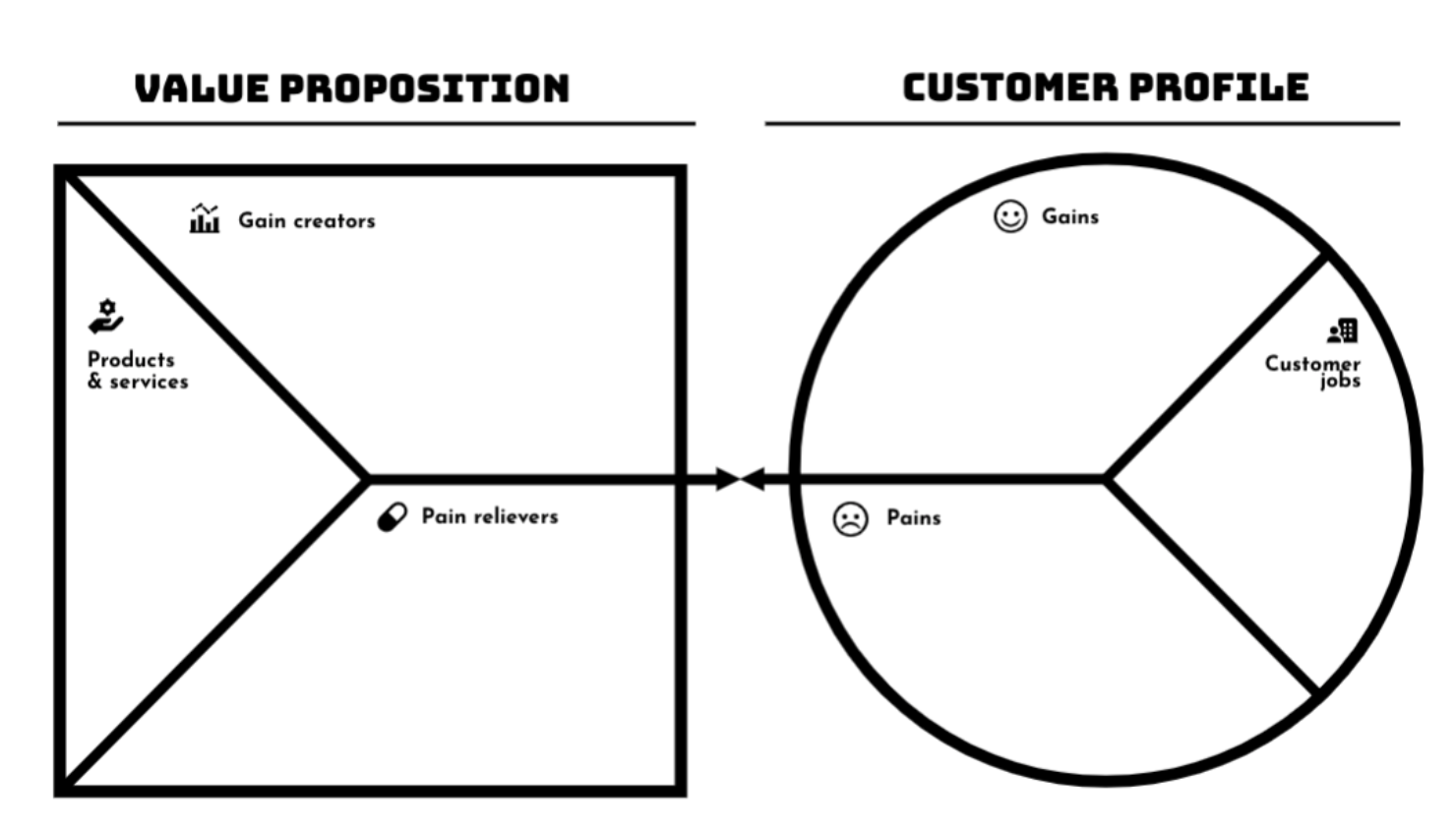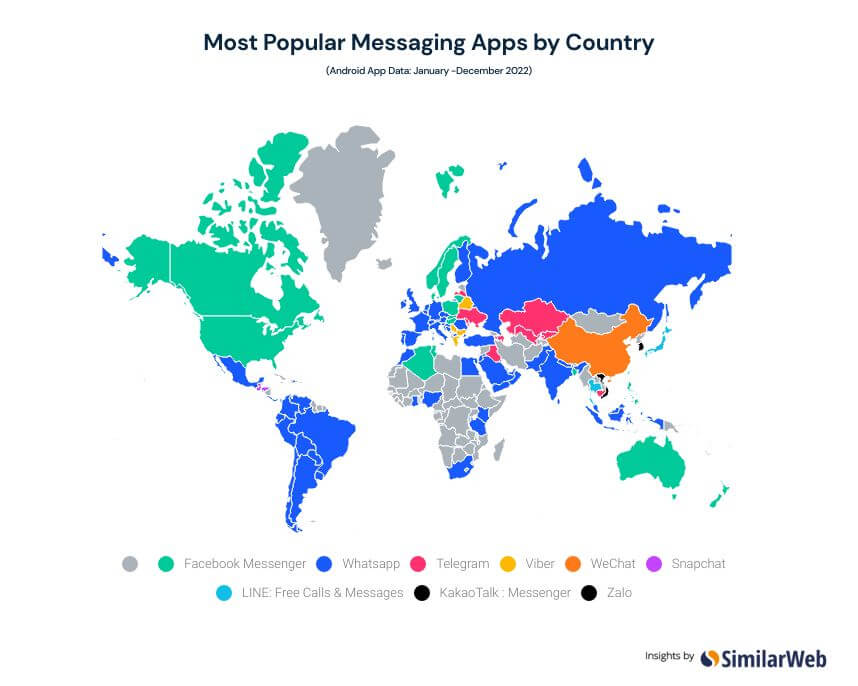Why does marketing messaging even matter? Really, you put so much work (and money) into “the right words”, what’s it all about? Well, the truth is — messaging that connects your audience to what you offer is the key piece of the puzzle in emotionally connecting with your potential audience and getting them to take the next (or first) step in your funnel. But getting there should not rely on quick scans of your competitors’ ads and guesswork. It should rely on asking good questions about who your target market is and what you offer them that truly improves your life.
That’s why we developed the Value Proposition Canvas — our methodology that helps us to connect the product to the market to the right message. Our unique approach gets us results every time, and we think it’s an ideal approach for early-stage B2B startups. This is why we love it, why we use it (hundreds of times for our customers, and counting) and it’s also the secret sauce behind writing content that works.
Read on to learn!
[And scroll down for our template! We expect you to steal it!]
What is the Benefit of the Value Proposition Canvas?
The Value Proposition Canvas allows businesses to gain a deep understanding of their target market and create the types of products and services that meet their needs. By analyzing your potential customers’ jobs, pains, and gains; you can identify opportunities to differentiate yourself from your competitors and create really compelling marketing that shines.
Our Value Proposition Canvas methodology offers a structured framework to systematically analyze and understand your potential customers. This framework consists of two main components: the customer profile and the value map.
This is not like the ICP or Persona development you may have done. This analysis goes beyond simple demographics and explores the deeper motivations and aspirations of your potential clients as it specifically relates to the challenges that your particular product or service might solve. By understanding the jobs customers are trying to get done, the pain they experience (ie: the challenges they encounter trying to meet their goals), and the gains they desire, you’ll develop a clearer picture of your target market and design intuitive-feeling marketing that gets to the heart of how your solution is their solution.
Investing in Creating the Right Messaging Leads to Effective Marketing
Effective marketing is crucial for any business to thrive and reach its target audience. However, without the right messaging, even the most well-designed marketing campaign can fall flat. This is where the Value Proposition Canvas comes into play.
With the Value Proposition Canvas – you’ll develop messaging that speaks to your target market’s specific needs, desires, and challenges, making them more likely to pay attention and take action. By integrating the findings from the Value Proposition Canvas into your marketing efforts, you can create a cohesive and impactful marketing campaign that resonates loudly with your target market.
The bottom line is that the right messaging is crucial.
Understanding Your Customer’s Needs and Expectations
Once the customer profile is established, the value map comes into play. This component helps businesses identify the unique value they can offer their customers.
By using the Value Proposition Canvas as your map you’ll learn:
- Which pain points are the strongest for your target market.
- The ongoing impact of their challenges on them, information you can utilize in writing marketing.
- Which of your product offerings has the potential to resonate most deeply as a solution for your customers.
- Potential unmet needs — gaps in the market — where you can offer your product as a solution.
With these findings you can develop powerful value proposition messaging that sets you apart from your competitors and speaks directly to the heart of your target market’s needs and hopes.
This knowledge goes beyond marketing — alignment with your target market’s pain can inform your entire customer lifecycle journey, you can tailor your customer service and product messaging around this knowledge, increasing the likelihood of customer satisfaction and loyalty, ultimately leading to long-term business success.
The Psychology of Why People Buy Things
It’s really valuable to take some time to understand the psychology behind people’s buying decisions. There are so many reasons why individuals choose to buy certain products or services. These factors include emotional triggers, social influence, perceived value, and personal beliefs. By understanding these psychological drivers, businesses can craft messaging that speaks directly to their customer’s desires and motivations.
Market psychology is large and fascinating field, while not necessary, we highly encourage people to spend some time learning about the patterns and trends in human behavior that help us to understand buying patterns overall, and shed some insight into why this methodology (and many others — though we’re partial to this one) work over and over again.
How To Use the Value Proposition Canvas
Always Start with the Customer
In order for a business to succeed, it is crucial to understand the needs and wants of the customer — and the best way to do this is to roll up your sleeves and dig into some market research.
You can gather qualitative data about customer needs and wants through approaches such as message mining. This involves analyzing all the feedback your company has received from your existing customers. This includes customer feedback, reviews, and other product comments. With this information in hand, you’ll be able to observe some common themes and use this knowledge to develop solutions that address these specific needs.
Another really valuable approach is through conducting customer and user interviews. By directly engaging with customers and asking high-quality questions, you can gain valuable insights into your existing customer’s preferences, pain points, and expectations. These interviews are a gold mine and a much better replacement for the old-fashioned survey.
Deeply understanding the core needs and core wants of the customer is your business’s silver bullet for writing a successful value proposition. Beyond writing effective marketing — it’s the research that confirms whether you have a true product-market fit and ultimately is a huge driver of lower marketing costs, as you’ll have confidence that you’re investing your paid budget in targeting the right audiences.
Ask Enough ‘Whys’
When using the Value Proposition Canvas it is important to ask enough “whys.” By continuously asking “why,” you can delve deeper into the motivations and desires of your target audience, allowing you to better understand their core pains and their core values.
Asking “why” helps you to go beyond surface-level responses and get to the root of what truly moves and inspires your customers. It helps you to uncover the underlying reasons behind their behaviors and preferences, allowing you to develop core messages that will really connect with them.
Make sure you ask “why” in every area of your Value Proposition Canvas.
Jobs refer to the tasks or problems that your customers are trying to solve, and asking “why” helps you understand the ultimate goals or outcomes they are trying to achieve.
Pain points are the negative experiences or frustrations your customers face, and by asking “why,” you can illuminate the depth of their most challenging obstacles and get to the heart of the solutions you can offer.
Gains, on the other hand, are the positive outcomes or benefits your customers desire, and asking “why” helps you understand their motivations and aspirations.
When considering jobs, pains, and gains, it is important to look at both social, emotional, and functional aspects. Social benefits or social consequences play a huge role here — how will their reputation or their businesses’ reputation be impacted by not solving their challenge at hand, for instance. Emotional aspects relate to how your product or service makes your customers feel, for example, will your solution help them save money or offer them an advantage over their competitors? This will give them joy and relief! Functional aspects include the practical or tangible benefits your customers seek. Perhaps what you offer increases the quality of their work, or makes something easier for them — identifying this will help you communicate it.
By asking enough “whys,” you can gain a deeper understanding of your target audience’s motivations and desires, allowing you to develop a more compelling value proposition that addresses their specific needs and aspirations.
Value Proposition Canvas Structure
Creating value propositions can be a complex task that requires a deep understanding of customers, their needs, and the market. By using the Value Proposition Canvas, you can identify and address the specific needs of your target audience, ensuring that the product or service you’re offering them provides real value for them.
This structure — done right (ie: we recommend it be approached thoughtfully and in a group discussion setting), serves as a valuable tool that will guide you through the intricacies of value proposition creation.
First: Define the Customer’s Jobs
Begin by making a list of jobs that your target market is tasked with accomplishing. focus specifically on those jobs that relate to your offering (you should have distinguished this when you developed your ICP — which you can learn about here) and try to understand how your customers are currently accomplishing (or failing to accomplish) those jobs.
Second: Lay out the Customer Pains
Once the customer jobs have been defined, the next step is to lay out the customer pains. Pains refer to the frustrations, difficulties, or challenges that customers experience when trying to solve their problems or accomplish their goals. Conduct research, surveys, or interviews to gather insights into the specific pains your target customers face, make a list of their pains, ranked for which are the most painful and relevant for your specific solutions.
Third: Uncover Customer Gains
Gains represent the positive outcomes, benefits, or desires that customers seek when using a product or service. By understanding these gains, you can design value propositions that create a compelling reason why potential customers might choose you and what you offer — instead of your competitors. Said simply, (and frequently) it’s the reason there’s an adage in marketing to focus on the benefits and not the features.
Research in Hand? Time to Write Your Value Propositions
Compose a Remarkable Value Proposition
Once you’ve completed the customer side of the Value Proposition Canvas, it’s time to move on to the value proposition side. A value proposition is a concise statement that communicates the unique value a product or service offers to its customers. It should clearly articulate the benefits, features, and differentiation that make the offering superior to alternatives in the market. Use the insights gathered from the customer side to craft a remarkable value proposition that directly addresses the jobs, pains, and gains of your target customers.
A Few Guidelines for Writing Your Value Propositions:
Guideline 1: Develop a unique value proposition for each buyer persona you serve.
When it comes to attracting and retaining customers, one of the most effective tools for businesses is a unique value proposition. This is especially true when developing a unique value proposition for each buyer persona you serve. By understanding the specific customer pain points and tailoring your products and services to solve them, you can stand out from the competition and create a strong connection with your target audience.
To effectively communicate the value of your products and services, it is important to use clear language that directly addresses a primary customer need. By focusing on the specific pain points of your buyer persona, you can show them how your offerings can provide a solution and improve their lives.
Additionally, it is essential to align the benefits of your offerings with the specific values of your customers. This means understanding what truly matters to your target audience and highlighting how your products and services cater to those values. By doing so, you not only communicate the value of your offerings but also connect at a deeper level with your customers.
Guideline 2: Always Think Like Your Customer
To create effective messaging, it is essential to think like a customer. This means putting yourself in their shoes and understanding their day-to-day activities, needs, and expectations. By doing so, you can develop a deeper understanding of their pain points and create messaging that resonates with them.
When thinking like a customer, it is important to consider their daily routines and activities. What are their priorities? What challenges do they face? By answering these questions, you can tailor your messaging to address their specific needs. For example, if your target audience consists of busy professionals, highlighting the convenience and time-saving benefits of your product or service may be crucial.
Moreover, understanding customer expectations is key. What do they expect from a product or service in your industry? By meeting or exceeding these expectations, you can differentiate yourself from competitors and provide a superior customer experience.
Problem-solving tools like the ‘Five Whys’ can also be helpful in identifying customer needs. By continuously asking “why” until you reach the root cause of a problem, you can uncover insights about what customers truly want and address those needs in your messaging.
Guideline 3: Ensure Your Messaging Needs Fit
Ensuring a fit between your value proposition and your customer’s needs and wants is crucial for the success of your business. When your value proposition aligns with what your customers truly desire, it improves the likelihood of customer satisfaction, loyalty, and ultimately, business growth.
Make sure to take your freshly written value propositions back to your Canvas and ask yourself, “am I really showcasing what we offer and how it benefits my customer, given everything I know about them?” If you can’t answer with a resounding yes, you’ve still got some work to do.
Your Value Proposition Canvas in Action
Here’s two simplistic examples of how the formula works — obviously your real-world value proposition messaging should be much more resonant than this, you should feel excited and even inspired by the messaging you land on. You’ll know it’s right when you read it out loud.
- A food delivery service: Customer jobs – convenient meal solutions, Customer pains – lack of time to cook, high delivery fees, Customer gains – time-saving, variety of cuisine options, Value proposition – “Fresh, delicious meals delivered to your door in under 30 minutes.”
- An online learning platform: Customer jobs – skill development, knowledge acquisition, Customer pains – high costs of traditional education, lack of flexibility, Customer gains – improved career prospects, lifelong learning opportunities, Value proposition – “Unlock your potential with affordable and flexible online courses from industry-leading experts.”
Pro Tip: Once you’ve got your value proposition brainstorms written out — it’s a great idea to take your top favorite ones and test them out. You can A/B test on a single variable such as an email or landing page; or you can go further and develop distinct funnels with each proposition, broadcasting your messages loudly and investing budget and several weeks in seeing which of your messages really hit the mark best.
Final Notes: Your Value Proposition vs Tagline vs Slogan
A quick final note (because this comes up often), it’s important to distinguish between a value proposition, tagline, and slogan.
While they may appear similar, they serve different purposes:
- A value proposition outlines the unique value that a product or service offers to customers.
- A tagline captures the essence of a brand or product and helps establish brand recognition.
- A slogan is a catchy phrase or statement that reinforces a brand’s message and differentiates it from competitors.
These should not be identical, but there can definitely be overlap! Of course, everything you create should be unified on tone and brand vibe.
In short, the Value Proposition Canvas — and our methodology for developing key messaging — is a valuable tool for businesses to understand their customers and create compelling value propositions that resonate with their target audience. By thoroughly analyzing customer jobs, pains, and gains, companies can design products and services that address unmet needs and provide remarkable value to customers.
We hope this is helpful and are happy to answer questions should you encounter them on your marketing content creation journey!
(We’re proud HubSpot partners and strongly encourage you to check out their content on the same topic, as well as their Value Proposition Canvas Template by clicking here).


















